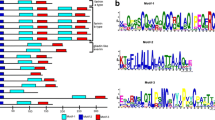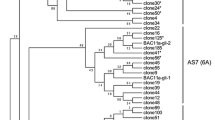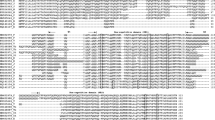Abstract
Brachypodium distachyon, is a new model plant for most cereal crops while gliadin is a class of wheat storage proteins related with wheat quality attributes. In the published B. distachyon genome sequence databases, no gliadin gene is found. In the current study, a number of gliadin genes in B. distachyon were isolated, which is contradictory to the results of genome sequencing projects. In our study, the B. distachyon seeds were found to have no gliadin protein expression by gel electrophoresis, reversed-phase high-performance liquid chromatography and Western blotting analysis. However, Southern blotting revealed a presence of more than ten copies of α-gliadin coding genes in B. distachyon. By means of AS-PCR amplification, four novel full-ORF α-gliadin genes, and 26 pseudogenes with at least one stop codon as well as their promoter regions were cloned and sequenced from different Brachypodium accessions. Sequence analysis revealed a few of single-nucleotide polymorphisms among these genes. Most pseudogenes were resulted from a C to T change, leading to the generation of TAG or TAA in-frame stop codon. To compare both the full-ORFs and the pseudogenes among Triticum and Triticum-related species, their structural characteristics were analyzed. Based on the four T cell stimulatory toxic epitopes and two ployglutamine domains, Aegilops, Triticum, and Brachypodium species were found to be more closely related. The phylogenetic analysis further revealed that B. distachyon was more closely related to Aegilops tauschii, Aegilops umbellulata, and the A or D genome of Triticum aestivum. The α-gliadin genes were able to express successfully in E. coli using the functional T7 promoter. The relative and absolute quantification of the transcripts of α-gliadin genes in wheat was much higher than that in B. distachyon. The abundant pseudogenes may affect the transcriptional and/or posttranscriptional level of the α-gliadin in B. distachyon.






Similar content being viewed by others
Abbreviations
- A-PAGE:
-
Acidic polyacrylamide gel electrophoresis
- LMW-GS:
-
Low molecular weight glutenin subunits
- LC-MS/MS:
-
Ion trap liquid chromatography-electrospray ionization tandem mass spectrometry
- RP-HPLC:
-
Reversed-phase high-performance liquid chromatography
- SDS-PAGE:
-
Sodium dodecyl sulphate polyacrylamide gel electrophoresis
- SNPs:
-
Single-nucleotide polymorphisms
- InDels:
-
Insertions/deletions
References
Allaby RG, Banerjee M, Brown TA (1999) Evolution of the high molecular weight glutenin loci of the A, B, D, and G genomes of wheat. Genome 42:296–307
An X, Zhang Q, Yan Y, Li Q, Zhang Y, Wang A et al (2006) Cloning and molecular characterization of three novel LMW-i glutenin subunit genes from cultivated einkorn (Triticum monococcum L.). Theor Appl Genet 113:383–395
Anderson OD, Greene FC (1997) The α-gliadin gene family II: DNA and protein sequence variation, subfamily structure, and origins of pseudogenes. Theor Appl Genet 95:59–65
Anderson OD, Litts JC, Gautier MF, Greene FC (1984) Nucleic acid sequence and chromosome assignment of a wheat storage protein gene. Nucleic Acids Res 12:8129–8144
Bartels D, Thompson RD (1986) Synthesis of mRNAs coding for abundant endosperm proteins during wheat grain development. Plant Sci 46:117–125
Bittner C, Grassau B, Frenzel K, Baur X (2008) Identification of wheat gliadins as an allergen family related to baker's asthma. J Allergy Clin Immun 121:744–749
Colot V, Robert LR, Kavanagh TA, Bevan MW, Thompson RD (1987) Localization of sequences in wheat endosperm protein genes which confer tissue-specific expression in tobacco. Embo J 6:3559–3564
Cornell HJ, Wills-Johnson G (2001) Structure-activity relationships in coeliac–toxic gliadin peptides. Amino Acids 21:243–253
D'Aloisio E, Paolacci AR, Dhanapal AP, Tanzarella OA, Porceddu E, Ciaffi M (2010) The protein disulfide isomerase gene family in bread wheat (T. aestivum L.). BMC Plant Biol 10:101
Draper J, Mur LAJ, Jenkins G, Ghosh-Biswas GC, Bablak P, Hasterok R et al (2001) Brachypodium distachyon: a new model system for functional genomics in grasses. Plant Physiol 127:1539–1555
Faris JD, Zhang Z, Fellers JP, Gill BS (2008) Micro-colinearity between rice, Brachypodium and T. monococcum at the wheat domestication locus Q. Funct Integr Genomic 8:149–164
Gao LY, Ma WJ, Chen J, Wang K, Jing L, Wang SL (2010) Characterization and comparative analysis of wheat high molecular weight glutenin subunits by SDS-PAGE, RP-HPLC, HPCE, and MALDI-TOF-MS. J Agric Food Chem 58:2777–2786
Gibbon BC, Larkins BA (2005) Molecular genetic approaches to developing quality protein maize. Trends Genet 21:227–233
Gu YQ, Wanjugi H, Coleman-Derr D, Kong XY, Anderson OD (2010) Conserved globulin gene across eight grass genomes identify fundamental units of the loci encoding seed storage proteins. Funct Integr Genomics 10:111–122
Hong SY, Seo PJ, Yang MS, Xiang F, Park CM (2008) Exploring valid reference genes for gene expression studies in Brachypodium distachyon by real-time PCR. BMC Plant Biol 8:1
Huo N, Lazo GR, Vogel JP, You FM, Ma YQ, Hayden DM et al (2008) The nuclear genome of Brachypodium distachyon: analysis of BAC end sequences. Funct Integr Genomics 8:135–147
International Brachypodium Initiative (2010) Genome sequencing and analysis of the model grass Brachypodium distachyon. Nature 463:763–768
Kasarda DD, D'Ovidio R (1999) Deduced amino acid sequence of an alpha-gliadin gene from spelt wheat (spelta) includes sequences active in celiac disease. Cereal Chem 76:548–551
Kawaura K, Mochida K, Ogihara Y (2005) Expression profile of two storage-protein gene families in hexaploid wheat revealed by large-scale analysis of expressed sequence tags. Plant Physiol 139:1870–1880
Kellogg EA (2001) Evolutionary history of the grasses. Plant Physiol 125:1198–1205
Kimura M (1977) Preponderance of synonymous changes as evidence for the neutral theory of molecular evolution. Nature 267:275–276
Kumar S, Mohan A, Balyan HS, Gupta PK (2009) Orthology between genomes of Brachypodium, wheat and rice. BMC Res Notes 2:93
Larré C, Penninck S, Bouchet B, Lollier V, Tranquet O, Denery-Papini S et al (2010) Brachypodium distachyon grain: identification and subcellular localization of storage proteins. J Exp Bot 61(6):1771–1783
Laudencia-Chingcuanco DL, Vensel WH (2008) Globulins are the main seed storage proteins in Brachypodium distachyon. Theor Appl Genet 117:555–563
Li XH, Ma WJ, Gao LY, Zhang YZ, Wang AL, Ji KM (2008) A novel chimeric LMW-GS gene from the wild relatives of wheat Ae. kotschyi and Ae. juvenalis: evolution at the Glu-3 loci. Genetics 180:93–101
Li QY, Ji KM, Zhang YZ, An XL, He ZH, Xia XC et al (2009) Characterization of monoclonal antibodies specific to wheat glutenin subunits and their correlation with quality parameters. Can J Plant Sci 89:11–19
Li X, Wang K, Wang S, Gao L, Xie Z, Hsam S et al (2010) Molecular characterization and comparative transcriptional analysis of LMW-m-type genes from wheat (Triticum aestivum L.) and Aegilops species. Theor Appl Genet 121:845–856
Nei M, Gojobori T (1986) Simple methods for estimating the numbers of synonymous and nonsynonymous nucleotide substitutions. Mol Biol Evol 3:418–426
Rozas J, Sanchez-DelBarrio JC, Messeguer X, Rozas R (2003) DNA polymorphism analyses by the coalescent and other methods. Bioinformatics 19:2496–2497
Shewry PR, MiXin BJ, Kasarda DD (1984) The structural and evolutionary relationships of the prolamin storage proteins of barley, rye and wheat. Philosl T Roy Soc L 304:297–308
Shewry PR, Tatham AS, Halford NG (1999) The prolamins of the Triticeae. In: Shewry PR, Casey R, Shewry PR, Casey R (eds) Seed proteins. Kluwer Academic Publishers, Dordrecht
Van Herpen T, Goryunova SV, van der Schoot J, Mitreva M, Salentijn E, Vorst O et al (2006) Alpha-gliadin genes from the A, B, and D genomes of wheat contain different sets of celiac disease epitopes. BMC Genomics 7:1–13
Wang K, Han XF, Dong K, Gao LY, Li HY, Ma WJ et al (2010) Characterization of seed proteome in Brachypodium distachyon. J Cereal Sci 52:177–186
Wang SL, Wang K, Chen GX, Lv DW, Han XF, Yu ZT et al (2012) Molecular characterization of LMW-GS genes in Brachypodium distachyon L. reveals highly conserved Glu-3 loci in Triticum and related species. BMC Plant Biol 12:221
Wieser H (2001) Comparative investigations of gluten proteins from different wheat species. III. N-terminal amino acid sequences of α-gliadins potentially toxic for coeliac patients. Eur Food Res Technol 213:183–186
Xie Z, Wang C, Wang K, Wang S, Li X, Zhang Z et al (2010) Molecular characterization of the celiac disease epitope domains in α-gliadin genes in Aegilops tauschii and hexaploid wheats (Triticum aestivum L.). Theor Appl Genet 121:1239–1251
Xu JH, Messing J (2008) Organization of the prolamin gene family provides insight into the evolution of the maize genome and gene duplications in grass species. Proc Natl Acad Sci U S A 105:14330–14335
Xu JH, Messing J (2009) Amplification of prolamin storage protein genes in different subfamilies of the Poaceae. Theor Appl Genet 119:1397–1412
Yan Y, Hsam SLK, Yu JZ, Jiang Y, Zeller FJ (2003) Allelic variation of the HMW glutenin subunits in Aegilops tauschii accessions detected by sodium dodecyl sulphate (SDS-PAGE), acid polyacrylamide gel (A-PAGE) and capillary electrophoresis. Euphytica 130:377–385
Yue SJ, Li H, Li YW, Zhu YF, Guo JK, Liu YJ et al (2008) Generation of transgenic wheat lines with altered expression levels of 1Dx5 high-molecular weight glutenin subunit by RNA interference. J Cereal Sci 47:1–161
Acknowledgments
This research was financially supported by grants from the Chinese Ministry of Science and Technology (2009CB118303), the National Natural Science Foundation of China (31271703 and 31101145), and Key Project of National Plant Transgenic Genes of China (2011ZX08009-003-004 and 2011ZX08002-004).
Author information
Authors and Affiliations
Corresponding authors
Additional information
G. X. Chen, D. W. Lv, and W. D. Li contributed equally to this work.
Electronic supplementary material
Below is the link to the electronic supplementary material.
Supplementary Table 1
Protein identification from SDS-PAGE bands in B. distachyon by LC-MS-MS (DOC 89 kb)
Supplementary Table 2
The positions of SNPs and InDels identified among 5 α-gliadin genes and other 19 genes from GenBank, including EF561278 (T. aestivum), DQ234066 (T. aestivum subsp. spelta ), HM120221 (T. aestivum ), EF569971 (T. aestivum subsp. sphaerococcum), EU018299 (T. aestivum), FJ441092 (T. monococcum), EF218656 (A. tauschii), GQ131532 (A. tauschii), EU849650 (Thinopyrum intermedium), HM452956 (Lophopyrum elongatum), EU849641 (L. elongatum), HM452983 (Eremopyrum bonaepartis), HM452981 (E. bonaepartis), HM452974 (Pseudoroegneria spicata), HM452970 (P. spicata), GU168577 (Dasypyrum breviaristatum), EU186107 (D. breviaristatum), HM585045 (Agropyron desertorum), and EU026395 (Australopyrum retrofractum). (DOC 93 kb)
Supplementary Table 3
The average number of each toxicity epitopes in α-gliadins from Brachypodium, Triticum, and related genomes. (DOC 81 kb)
Supplementary Table 4
A total of 530 α-gliadin genes from different Triticum related species used in this study (DOC 103 kb)
Supplementary Fig. 1
Mutliple alignment of the deduced amino acid sequences of 25 α-gliadin genes, including 6 cloned from Brachypodium and other 19 genes from Triticum and related species deposited in GenBank: EF561278, DQ234066, HM120221, EF569971, and EU018299 from T. aestivum; FJ441092 from T. monococcum; EF218656 and GQ131532 from A. tauschii; EU849650 from T. intermedium; HM452956 and EU849641 from L. elongatum; HM452983 and HM452981 from E. bonaepartis; HM452974 and HM452970 from P. spicata; GU168577 and EU186107 from D. breviaristatum; and HM585045 from A. desertorum and EU026395 from A. retrofractum. Black frames indicate the position of cysteine residues and dashes represent the deletions. The red frames of the aligned sequences show the position of the peptides, which had activity in CD (in the N-terminal domain) and associated with adenovirus type 12 infections (in the C-terminal domain). (DOC 170 kb)
Supplementary Fig. 2
Comparison of the 5′ flanking DNA sequences of 23 α-gliadin genes: four sequences from B. distachyon, include one sequence from diploid Bd3-1 and Bd21, respectively, two from tetraploid genotypes B347, and one from hexaploid Bd19; four sequences from Chinese Spring (CS); three sequences from T. monococcum L.; three sequences from A. comosa (MM), three sequences from A. umbellulata (UU), two sequences from A. markgrafii (CC), and three sequences from A. uniaristata (NN), respectively; −300 element, GCN motif, TATA box, and CAAT box are enclosed in a red box. In all genes, dot and dashes indicate the same sequences with Bd3-1 and deletion. (DOC 210 kb)
Supplementary Fig. 3
Specificity of qRT-PCR amplification. a The standard curve of the α-gliadin genes and housekeeping genes, including the amplification efficiencies and R 2 values (coefficient of determination). b Dissociation curves of the α-gliadin genes showing single peaks (each including three technical replicates for each of 12 cDNA pools from developmental stages). c Agarose gel (2 %) showing the amplification of a single specific PCR product of expected size for the α-gliadin genes and housekeeping genes. (DOC 1544 kb)
Supplementary Fig. 4
Multiple alignment of the deduced amino acid sequences of α-gliadin gene (FJ159430) from wheat and prolamins (Bradi1g50300.1, Bradi2g39920.1, Bradi1g50205.1, Bradi1g50200.1, Bradi2g39940.1, Bradi2g38530.1, and Bradi1g50307.1) from B. distachyon, which were blast and obtained from the B. distachyon genome project Websites (http://www.brachypodium.org/). (DOC 4028 kb)
Rights and permissions
About this article
Cite this article
Chen, G.X., Lv, D.W., Li, W.D. et al. The α-gliadin genes from Brachypodium distachyon L. provide evidence for a significant gap in the current genome assembly. Funct Integr Genomics 14, 149–160 (2014). https://doi.org/10.1007/s10142-013-0353-0
Received:
Revised:
Accepted:
Published:
Issue Date:
DOI: https://doi.org/10.1007/s10142-013-0353-0




